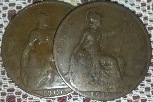© paperbacKnow limited 2013 -









Following their year recreating a wartime farm at Manor Farm in Hampshire, Ruth and Peter return to recreate 1944. Like Tudor Monastery Farm, there is no Alex Langlands.
Work on the farm goes on, of course. The crops aren’t growing in the middle of winter, so this is the ideal time for fixing hedges and ditches. It’s hungry work, so the team are pleased when a lady comes along with some pies.
After that, its onto preparing for a Christmas party.
A party wouldn’t be a party without some beer. But in 1944, barley was in short supply. So the boys decide to brew some potato beer.
The girls get to work making decorations from physalis and chaff.
While the beer is brewing, Peter looks for something to do with it (pending drinking it). The barrel is rotten. So he heads off to the potter to get some stone flagons.
For presents, Ruth makes some dolls house furniture out of household rubbish.
They head off to London by train. Clearly trains then ran on steam and there are no steam trains nowadays. So this section was filmed on an old branch line. Their destination is Chislehurst caves in south London where fifteen thousand south Londoners used to shelter from the blitz. Many North Londoners sheltered in the underground. But the more gravelly soil south of the Thames is less suited to tunnelling. So the railways in South London tend to run overground.
Manor Farm
Manor farm is just part of the Manor Farm and Country Park attraction at Botley in Hampshire. It’s open to visitors year round (except for a few days during the Christmas holiday. The farmhouse itself dates back to the fourteenth century, although the adjoining cottage was used more in the programme.
You can find out more on the Manor Farm and Country Park web site.
The Rural Pie Scheme
Free pies for agricultural workers. This sounds too good to be true. And in fact it is. The ladies delivering the pies were, indeed, volunteers. And their task was not easy at a time of petrol rationing. Otherwise, although orchestrated by the government, this was a commercial venture. The pies were baked on a massive scale by the commercial bakers and then sold via the volunteer force at fourpence per pie.
The Women’s Voluntary Service
The Women’s Voluntary Service was originally set up just before the outbreak of war as part of the ARP service to provide shelter and assistance during and after air raids. Its role grew, however, to include assisting with the evacuation of children from London during the blitz and, obviously, the pie scheme. Unlike some others, though, the WVS didn’t disband after the war, or even at the ending of the pie scheme. It continued with voluntary work -
In 1966, the service was honoured by the Queen and became the Women’s Royal Voluntary Service. 75 years, and three million volunteers on, they dropped the ‘Women’s’ from their name and became simply the Royal Voluntary Service. You can find out more about what they do, and what you can do, on the Royal Voluntary Service website.
Colin Richards
Colin Richards is Historic Environment Manager at Shropshire Council. But he is better know to us from his links with the Acton Scott farm at which Victorian Farm was filmed. There he runs a number of courses on historic crafts.
The Potter
The potter is Mike Fletcher from Wenlock Pottery in Much Wenlock, Shropshire. Apart from making pottery which you can buy in his shop, and appearing on television, he runs a B&B and offers pottery courses. You can find out more on the Wenlock Pottery website.
Chaff
A particular problem faced by the Luftwaffe during world war 2 was that the British kept trying to shoot them down. And they were quite good at it too. Why? We had search lights and we had radar, both of which made spotting planes a lot easier, even in the dark.
The Germans came up with a simple yet ingenious solution. They dropped little pieces of tinfoil from their planes. As they fluttered down to earth, they filled the sky with a mass of reflecty-
The Church
St Bartholomew’s church is right next to Manor Farm in Botley so would, indeed, have been where the farm workers worshipped. Dating from the 13th Century, it was originally All Saints church. But when the village grew, a larger All Saints Church was constructed and this one was rededicated to St Bartholomew. If you’re visiting Manor Farm, you could see this at the same time.
The Train
It’s been a great many years since you could get a steam train to London. But there are a few maintained by enthusiasts and running on old branch lines closed by Dr Beeching. In this case, it’s the Watercress line which runs from Ropley to Medstead and Four Marks in Hampshire. With four stations and a variety of landscapes and rollingstock, this is a popular filming location and has been featured many times on both the large and the small screen. For the most part, however, it is open to the public as a tourist attraction. You can find out more on the Watercress Line website.

The Travelling Post Office

Chislehurst Caves
In its day, this was the height of efficiency. Rather than sorting the letters and delivering them as two separate operations, the tasks were combined. Letters with a long way to go were sorted in travelling post offices on board trains. I’m not sure, however, whether the Watercress Line has one. What we are seeing is probably part of the the British Postal Museum and Archive. This operates across three sites in the UK, including The Museum of the Post Office in the Community at Blists Hill.
Blists Hill may be familiar as the location of Ruth Goodman’s non-
You can find out more about the British Postal Museum and Archive on its website here.
Although many people had Anderson shelters at home, these provided only limited protection from the bombing during world war 2. Many people sought greater security by going deeper underground. In North London they headed for the nearest underground station. But because the soil is more gravelly in South London and tunnelling more difficult, most trains run over ground. The stations therefore provide limited protection.
Chislehurst is home to a massice complex of deep underground caves, however. So it was here that some 15,000 South Londoners headed to shelter from the Blitz.
Chislehurst Caves is open today as a tourist attraction with guided tours every hour on the hour through the day. You can find out more on the Chislehurst Caves website
Ruth Goodman and Peter Ginn can currently be seen in Tudor Monastery Farm on BBC2 and on BBC iPlayer until 25th December 2013.